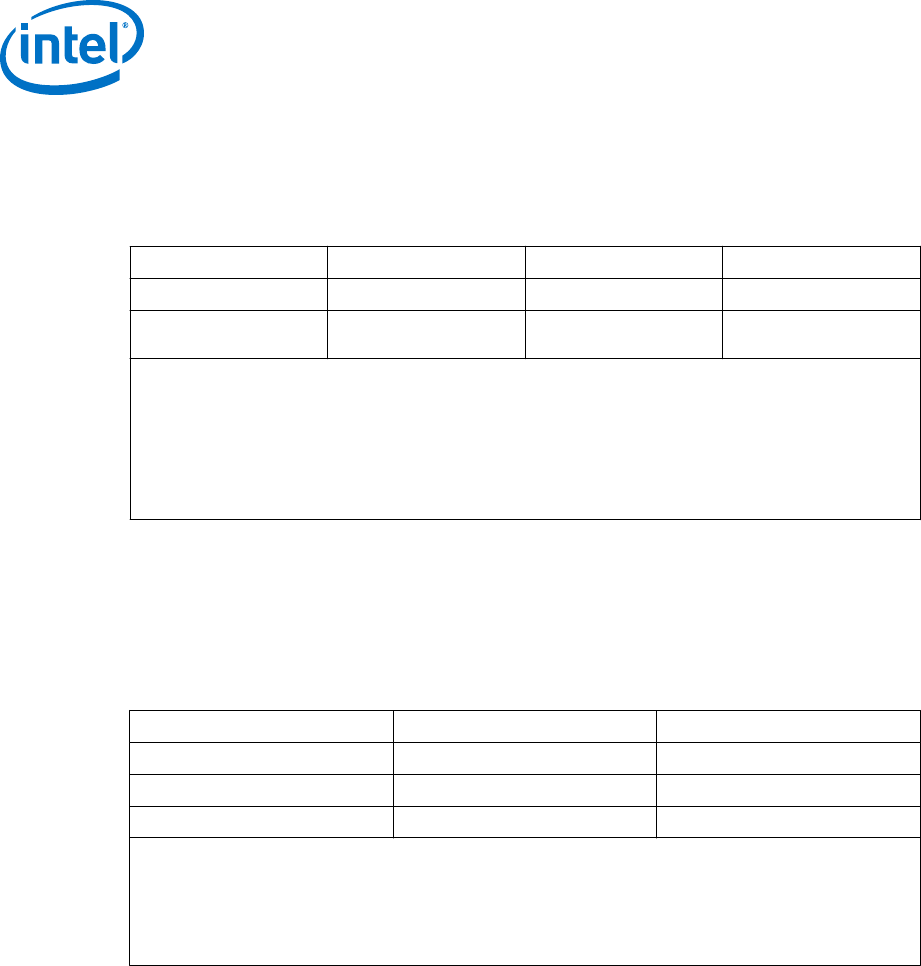Desktop 4th Generation Specification Sheet
Table Of Contents
- Contents
- Revision History
- 1.0 Introduction
- 2.0 Interfaces
- 3.0 Technologies
- 3.1 Intel® Virtualization Technology (Intel® VT)
- 3.2 Intel® Trusted Execution Technology (Intel® TXT)
- 3.3 Intel® Hyper-Threading Technology (Intel® HT Technology)
- 3.4 Intel® Turbo Boost Technology 2.0
- 3.5 Intel® Advanced Vector Extensions 2.0 (Intel® AVX2)
- 3.6 Intel® Advanced Encryption Standard New Instructions (Intel® AES-NI)
- 3.7 Intel® Transactional Synchronization Extensions - New Instructions (Intel® TSX-NI)
- 3.8 Intel® 64 Architecture x2APIC
- 3.9 Power Aware Interrupt Routing (PAIR)
- 3.10 Execute Disable Bit
- 3.11 Supervisor Mode Execution Protection (SMEP)
- 4.0 Power Management
- 4.1 Advanced Configuration and Power Interface (ACPI) States Supported
- 4.2 Processor Core Power Management
- 4.3 Integrated Memory Controller (IMC) Power Management
- 4.4 PCI Express* Power Management
- 4.5 Direct Media Interface (DMI) Power Management
- 4.6 Graphics Power Management
- 5.0 Thermal Management
- 5.1 Desktop Processor Thermal Profiles
- 5.2 Thermal Metrology
- 5.3 Fan Speed Control Scheme with Digital Thermal Sensor (DTS) 1.1
- 5.4 Fan Speed Control Scheme with Digital Thermal Sensor (DTS) 2.0
- 5.5 Processor Temperature
- 5.6 Adaptive Thermal Monitor
- 5.7 THERMTRIP# Signal
- 5.8 Digital Thermal Sensor
- 5.9 Intel® Turbo Boost Technology Thermal Considerations
- 6.0 Signal Description
- 6.1 System Memory Interface Signals
- 6.2 Memory Reference and Compensation Signals
- 6.3 Reset and Miscellaneous Signals
- 6.4 PCI Express*-Based Interface Signals
- 6.5 Display Interface Signals
- 6.6 Direct Media Interface (DMI)
- 6.7 Phase Locked Loop (PLL) Signals
- 6.8 Testability Signals
- 6.9 Error and Thermal Protection Signals
- 6.10 Power Sequencing Signals
- 6.11 Processor Power Signals
- 6.12 Sense Signals
- 6.13 Ground and Non-Critical to Function (NCTF) Signals
- 6.14 Processor Internal Pull-Up / Pull-Down Terminations
- 7.0 Electrical Specifications
- 8.0 Package Mechanical Specifications
- 9.0 Processor Ball and Signal Information

mechanical system or component testing should not exceed the maximum limits. The
processor package substrate should not be used as a mechanical reference or load-
bearing surface for thermal and mechanical solution.
Table 57. Processor Loading Specifications
Parameter Minimum Maximum Notes
Static Compressive Load — 600 N [135 lbf] 1, 2, 3
Dynamic Compressive
Load
— 712 N [160 lbf] 1, 3, 4
Notes: 1. These specifications apply to uniform compressive loading in a direction normal to the processor,
IHS.
2. This is the maximum static force that can be applied by the heatsink and retention solution to
maintain the heatsink and processor interface.
3. These specifications are based on limited testing for design characterization. Loading limits are
for the package only and do not include the limits of the processor socket.
4. Dynamic loading is defined as an 50g shock load, 2X Dynamic Acceleration Factor with a 500g
maximum thermal solution.
Package Handling Guidelines
The following table includes a list of guidelines on package handling in terms of
recommended maximum loading on the processor IHS relative to a fixed substrate.
These package handling loads may be experienced during heatsink removal.
Table 58. Package Handling Guidelines
Parameter Maximum Recommended Notes
Shear 311 N [70 lbf] 1, 4
Tensile 111 N [25 lbf] 2, 4
Torque 3.95 N-m [35 lbf-in] 3, 4
Notes: 1. A shear load is defined as a load applied to the IHS in a direction parallel to the IHS top surface.
2. A tensile load is defined as a pulling load applied to the IHS in a direction normal to the IHS
surface.
3. A torque load is defined as a twisting load applied to the IHS in an axis of rotation normal to the
IHS top surface.
4. These guidelines are based on limited testing for design characterization.
Package Insertion Specifications
The processor can be inserted into and removed from an LGA1150 socket 15 times.
The socket should meet the LGA1150 socket requirements detailed in the LGA1150
Socket Application Guide.
Processor Mass Specification
The typical mass of the processor is 27.0 g (0.95 oz). This mass [weight] includes all
the components that are included in the package.
Processor Materials
The following table lists some of the package components and associated materials.
8.3
8.4
8.5
8.6
Processor—Package Mechanical Specifications
Desktop 4th Generation Intel
®
Core
™
Processor Family, Desktop Intel
®
Pentium
®
Processor Family, and Desktop Intel
®
Celeron
®
Processor Family
Datasheet – Volume 1 of 2 December 2013
106 Order No.: 328897-004










